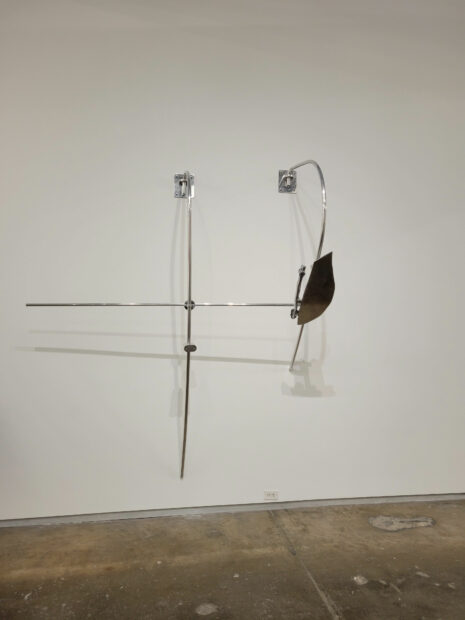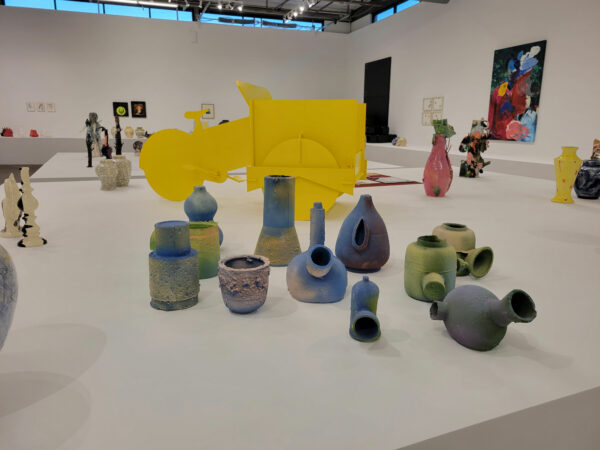
Installation View of “Cerámica Suro: A Story of Collaboration, Production, and Collecting in the Contemporary Arts” at Dallas Contemporary.
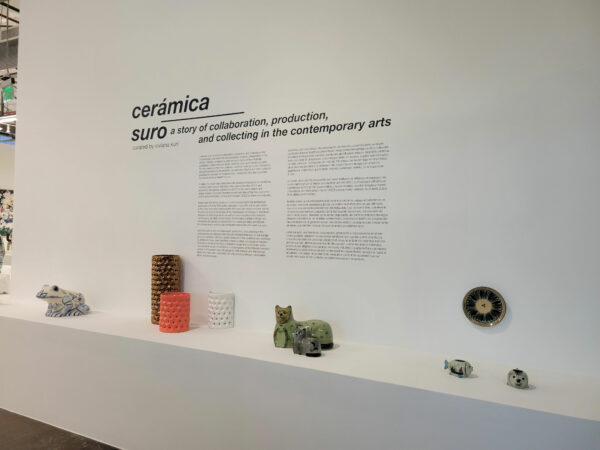
Installation View of “Cerámica Suro: A Story of Collaboration, Production, and Collecting in the Contemporary Arts” at Dallas Contemporary.
How does one tell the story of a workshop? Dallas Contemporary explores the complicated web of individuals and relationships that form the story of Cerámica Suro with Cerámica Suro: A Story of Co llaboration, Production, and Collecting in the Contemporary Arts. The exhibition provides the first United States retrospective of the eponymous ceramics studio in Guadalajara, Mexico. The modest decorative wares found on the show’s opening wall set the stage for the early works that reflect the studio’s focus during its first decades. However, this exhibition is really about the vision of José Noé Suro and the creative relationships he forged that launched a new chapter in the studio’s history. Joining his family’s business in 1993, Suro quickly reimagined Cerámica Suro as a collaborative arts incubator, inviting artists from around the world to come, collaborate, and experiment.
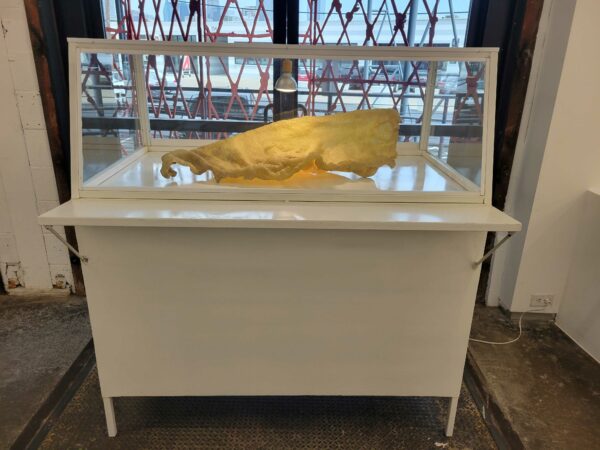
Gabriel Kuri (México, 1970), “Sin título (Doy fe) [Untitled (Doy fe)],” 1998, vitrine, fiberglass chicharrón
Similarly, Kuri’s work also invites visitors to reimagine the labor involved in the arts that decorate their world, but have been historically dismissed as less-than. By working at large scale with unexpected materials but familiar subjects, viewers are encouraged to take a fresh look at what constitutes fine art and the power dynamics involved in its consumption. In his acquisition of this work and the development of his personal collection with notable representation by Mexican artists, women artists, and other artists of color, Suro provided an important intervention to the primacy often given to United States and European collections.
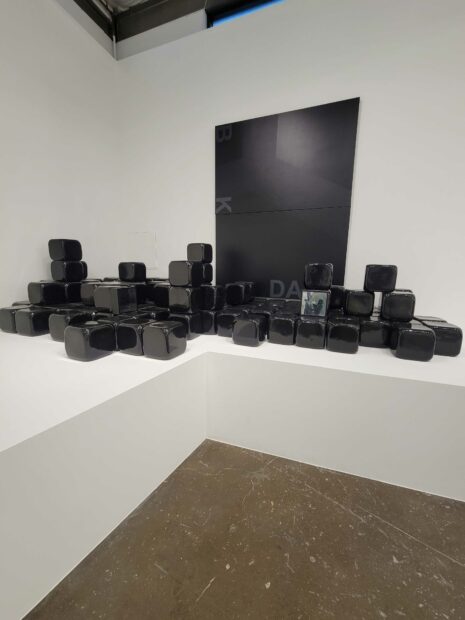
Adam Pendleton (United States, 1984), “Sin título [Untitled],” n.d., glazed ceramic and Black Dada (BK/DA), n.d., diptych
In this exhibition, Pendleton’s Black Dada is brought to ceramics. Several beautifully glazed black cubes are arranged and stacked in front of a diptych painting also by the artist. Two of the cubes include mirrored elements, literally allowing viewers to find themselves in the work. Ceramics as a medium is a wonderful fit for Pendleton’s practice. His work has been described by his gallery (Pace Gallery) as exploring the sensorial nature of how people experience the world. Here, he allows us to further relate to the work through our own prior experiences with ceramics, a form many of us encounter in our daily lives, without much thought. With this sculpture, viewers are invited to stop and truly appreciate the visual potential of the medium, particularly in its abundance.
Ultimately this exhibition is Suro and his wife, Marcela Preciado’s, personal collection, thus it is not strictly a ceramics show. Under Suro’s leadership, Cerámica Suro has embarked upon more than 500 collaborations with artists and has become a leading arts incubator. Nairy Baghramian’s Scruff of the Neck graces the wall near the rear of the exhibition. With its thin, intersecting steel rods and elegantly cut metal sheet, this minimalist work is a striking break from the heavily filled pedestals running throughout Dallas Contemporary’s gallery.
Although seemingly pure sculpture, Baghramian’s work reflects a strong interest in interior design and the histories of art and design, specifically the roles of women in these histories. How are objects given gendered labels and placed in hierarchies based on those labels? The artist’s experimental style truly explores the forms and shapes that materials can take, blurring gendered delineations through the juxtaposition of delicate forms in a sturdy medium. Her work, as well as the paintings and works on paper displayed in this exhibition, highlight Suro’s interest in contemporary art broadly, and provides a mini-capsule of works created from the turn of the twenty-first century to the present.

Sara C. Pereyra (México), “Basic Trays,” 2017, ceramic; Cecilia León de la Barra (México, 1975), “Market Pots,” 2017, glazed ceramic; and Moises Hernández (México, 1983), “Sin título,” n.d.
While many of the pieces in this exhibition are experimental and wide-ranging in material, there is still an abundance of ceramics. They serve as the core of the collection and highlight Suro’s interest in functional productions and industrial design. What I appreciated most about these works is how they reflect the change in tastes over the decades. In comparison to the subdued tones of the early Cerámica Suro productions, a selection of brightly colored wares draws visitors near. Also, the beautifully shaped designs, many with the ability to nest, reflect an attention to everyday utility.

Cynthia Gutiérrez (México, 1978), “Fragmentos de grandeza,” 2018, plaster and metal, variable dimensions

Cynthia Gutiérrez (México, 1978), “Fragmentos de grandeza,” 2018, plaster and metal, variable dimensions.
Near the exit (also the entrance) of the show, one cannot help but marvel at Cynthia Gutiérrez’s Fragmentos de grandeza. Gutiérrez crafted two white plaster columns with Corinthian capitals that have been broken apart, as if debris from ruins. I personally was drawn to this sculpture because of the duality of strength and weakness inherent in this piece and also in her practice as a whole. She draws upon the familiar subject of a Greek column to address our own sense of memory and narrative, particularly looking at when it breaks apart. In many ways, Gutiérrez’s artwork mirrors Cerámica Suro in the art world: Suro has disrupted tidy narratives about an art world that marginalizes ceramics and artistic centers outside of the United States and Europe. Suro’s collection is offering a new counter-story that challenges the singular, uniform vision of the art world that we often desperately seek in an effort to create neat eras and stylistic designations.

Installation View of “Cerámica Suro: A Story of Collaboration, Production, and Collecting in the Contemporary Arts” at Dallas Contemporary.
It is worth stating that the layout of the exhibition at Dallas Contemporary is abundant, to the point of being overwhelming. Capturing the creation of a workshop and the passions of collectors in a single exhibition is a tall order. Rather than isolating differing themes in separate sections, the exhibition tells an interwoven, overlapping story that is reflective of Suro’s journey. One visit does not adequately allow visitors to fully appreciate the unique nuances of the varying works. Yet, the endeavor is well worth it for visitors wanting to enjoy spectacular ceramics and a new narrative in the canon of late twentieth and early twenty-first century art.
Cerámica Suro: A Story of Collaboration, Production, and Collecting in the Contemporary Arts is on view at Dallas Contemporary through December 31, 2023.


